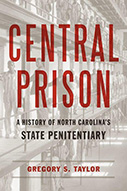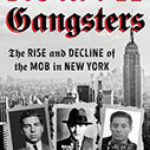Central Prison: A History of North Carolina’s State Penitentiary

Author: Gregory S. Taylor
Publisher: Louisiana State University Press, 2021. 328 pages
Reviewer: Paul Knepper ǀ November 2021
Gregory S. Taylor delivers a detailed and insightful history of the primary institution in North Carolina’s prison system. Central Prison: A History of North Carolina’s State Penitentiary covers more than two hundred years, from the late eighteenth century, when lawmakers first considered the idea of building a penitentiary, to the early decades of the twenty-first century, when prison officials struggled to address a mental health crisis among the prisoner population.
Central Prison affords a worthwhile topic for a book. Taylor describes a major state prison outside the model institutions that occupy such a large role in histories of criminal justice. Histories of law and criminal justice in the United States typically recall the debate between proponents of the Pennsylvania and Auburn models to explain American prison experience in the nineteenth century. A discussion of model institutions, however, is not enough. As Taylor points out, although North Carolina referenced the Auburn model, the commitment was never deep. He suggests that in fact, the founders did not really advance a vision for the prison while planning for its construction in the 1870s. Rather, in the 1880s, after the prison opened, officials turned to the issue of prison philosophy and considered the rationale for the institution they created.
North Carolina was among the last states to build a penitentiary. In 2021, when the impact of mass incarceration has become a national conversation, the state’s reluctance to establish a prison could be seen as a positive thing. But it would be hard to make this argument. The absence of a prison did not indicate the presence of a better alternative. Before, and after, North Carolina pursued severe measures. The state relied on the pillory, whipping post, and branding well into the nineteenth century. The legislature approved convict leasing, which allowed the railways to expand their networks, and when the railway boom ended, authorized chain gangs, so that counties could join the state’s “good roads movement”.
Taylor presents some familiar themes in prison history, none more so than state politics. He portrays the politicians in Raleigh as quarrelsome and ineffective, unable to manage the reform of lawbreakers alongside the security of the public. For most of the nineteenth century, political leaders failed to come up with a plan. By the time they completed Central Prison in 1884, the penitentiary model was already out-of-date. The reformatory movement was underway. Sparked by the “new penology” at Elmira, NY, in 1876, a science of rehabilitation through education superseded moral views of penitence and solitude. Throughout his account, Taylor identifies state politics as the driving force behind changes in prison management; politicians wrangled over finances, penal philosophy, and perceptions of public attitudes. He details corruption and scandals in finances as well as abuse of prisoners, which led to legal challenges in the twentieth century. He examines the choice to make the prison part of the State Highway Department, and the impact of that on the institution.
Taylor also relies on some familiar strategies in writing institutional history. He organizes chapters around the careers of leading reformers, such as George Pou, superintendent in the 1920s, and Governor Max Gardner in the 1930s. Pou announced a series of improvements in the routine and facilities during the Depression years. At the same time, Taylor introduces a number of those confined at the prison through the years, particularly victims of the exploitation and corruption at the center of scandals and litigation. He presents Otto Wood, a convicted murderer who escaped three times; Jimmie Lee Foster, the first to die in the gas chamber; Eleanor Rush, starved to death while held in isolation; and Andrew Brauch, killed during a riot when a tear gas canister struck him in the head.
There is much more to Central Prison than just the account of a state institution. Taylor covers such a long period of time, and provides a level of detail, that makes his history valuable for anyone interested in the wider history of imprisonment. He details shifting policies and practices common to prisons across the USA. During the 1930s, the legislature authorized works at Central Prison to support state industries, including a plant for pouring concrete culvert, a printing press, and a factory for stamping license plates. In 1967, the General Assembly renamed the Department of Prisons the Department of Correction, and transformed prison guards into correctional officers. North Carolina experimented with prisoner unions in the 1970s, resorted to “triple bunking” in response to overcrowding in the 1980s, and struggled with mental health and solitary confinement issues in the 1990s and 2000s.
The author includes a discussion of women at the prison. Even before its opening, there were already female inmates. Of the first three prisoners to arrive at the construction site in 1870, two were women. For decades, women endured makeshift conditions; they suffered from neglect, isolation, lack of privacy, and threats of sexual violence. Governor Gardner authorized a separate structure in the 1930s, but the need for genuine reform persisted. During the 1960s, female inmates joined the males, organized, rioted, and pursued changes to end abuse and advocate for improvements.
In one of his final chapters, Taylor counters the description of new facilities with a reprise of old problems. Here the value of historical perspective becomes evident. It becomes possible to understand why, despite changes in organization and management, the introduction of reforms and new resources, the problems of confinement remain so much the same year after year. On the surface, prison history changes with political winds; new initiatives and new language follow the schemes of political parties and their struggles for control. But, thinking about the prison over the long term is a story of continuity. The prison functions as part of the state government, but also as part of the national society and wider culture. This can be seen in the numbers Taylor provides about racial imbalance, the arithmetic of Black and White. Despite changes in policy and practice, Central Prison remains, since it opened in the nineteenth century, a place where the majority of prisoners are Black, and the staff are mostly White.
Racism has shaped each aspect of prison history. When North Carolina opened its women’s prison, it joined the few states in the South to build separate facilities for women. Yet these facilities were segregated: Dormitory A for African-Americans and Dormitory B for Whites. Lawmakers debated whether the gas chamber, installed at Central Prison in 1935, was more humane than the electric chair. But the racial identity of those executed at the prison, regardless of method, remained the same: African-American men. Investigations into scandals and corruption also provide a glimpse into the treatment Black prisoners received. In the 1970s, Joan Little became a champion for the rights of African American women when she used an ice pick to kill the white correctional officer who tried to rape her.
Central Prison does provide a window into the state’s history, its politics, economy, and public law and policy. From the perspective of prison administration, Central Prison could be read as a chronicle of failures. Despite decades of effort, the same problems remain—labor, mental health, security, and so on. Recalling this history can inform the next round of reforms — new buildings, programs, and initiatives. From the perspective of the inmate population over the years, it is also a story of failures. But reflecting on this history can lead to different questions about why the prison has failed for so long, and why it has failed for a particular population. Reading Central Prison, along with the wider history of imprisonment, much of which is referenced in the opening chapter, makes it an informative and evocative book.
Paul Knepper is a professor in the Department of Justice Studies, San José State University.


